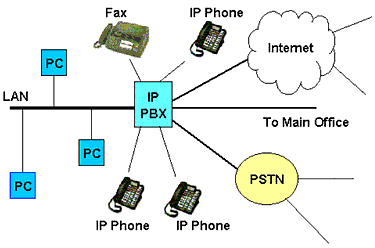|
|
 |

IP PBX
Technology Brief
PDF Version


What is an IP PBX?
A PBX is a customer premises telephone system that manages telephones in the enterprise and acts as the gateway to external voice networks. A switch/router directs incoming packets to the appropriate data network. Traditionally, two separate networks are required: one for voice and one for data.
Instead of two separate networks, one each for data and voice, only one network is needed if voice is packetized (Voice over IP) and sent over the data network.
An IP PBX is a combination of a switch/router and a PBX that handles Voice over IP (VoIP):

In an IP PBX, computers can be on a shared LAN that is connected to the IP PBX. Telephones, on the other hand, should be directly connected to the IP PBX. This avoids Quality of Service (QoS) issues that arise if both computers and telephones are on a shared LAN. In such a case, voice packets will have to compete with data packets for the shared LAN. Poor telephone voice quality will result if voice packets are not transmitted in a timely manner.
An IP PBX also acts as a gateway that provides voice connections (voice lines, T1s) to a LEC, a long distance company, etc. and data connections (cable, DSL, ISDN, E1) to a cable operator, a LEC, an ISP, etc. IP PBXs can be used bypass the circuit-switched telephone network by using the data network to connect to branch offices and other locations on the data network.
Using a single converged network that carries both voice (packetized) and data allows development of new services not typically available on the traditional network - for example, the use of one central directory across multiple locations and unified messaging.
An IP PBX replaces a traditional PBX. It can be used with
- an IP phones (with a built-in DSP chip that converts voices to IP packets and vice versa),
- a soft phone (software application on PCs that also converts voice to packets and vice versa), which is used with a headset or a handset,
- existing phones along adapters that packetize voice, and
- standard phones connected to PCs (PCs acts as the adapters).
As in case of computing devices, IP addresses are automatically assigned to phones as they connect to the system. This means that a telephone can be moved from one location on the network to another. The telephone number remains the same as it associated with the phone.
VoIP packets can be packetized using protocols such as G.711 or G.723:
- G.711: an encoding standard for packetized voice; uses 64 kbs and can communicate with other G.711 devices.
- G.723: an encoding standard for packetized voice that does compression; uses 6.4 kbs and can communicate with other G.723 devices but not G711 devices.
What are Some Issues with an IP PBX?
Two important issues are QoS and reliability:
- QoS issues (jitter and lost packets) arise when using VoIP on the public network.
- QoS issues (jitter) arise when a telephone and a PC are on a shared LAN - voice and data packets compete for the shared LAN.
- Traditional PBXs are known for their reliability. IP PBXs are built on PCs using commercial software applications. Consequently, their software may not be 100% reliable so as to give 24 ´ 7 operation with very little down time.
What are the Advantages of an IP PBX?
Compared to a conventional PBX, an IP PBX
- handles both voice and data,
- is cheaper since it requires only one network to install and maintain instead of two,
- reduces equipment costs (only IP based products; no voice products needed),
- reduces long distance charges for inter-branch office calls (by using the data network),
- is easier to provision (just plug in from wherever),
- supports services such as unified messaging,
- is more flexible,
- is more scalable,
- makes it easier to provide new services, such as data and video collaboration,
- allows remote configuration (over the Web), and
- supports modular software upgrades, new technologies (new CPUs, etc.) are easy to incorporate.
Where will an IP PBX be used?
IP PBXs are good candidates for being used particularly in
- new businesses which will avoid the costs of installing and maintaining two networks (its hard to replace equipment that works in existing offices)
- businesses that have many branches will reduce costs by
- avoiding long distance charges incurred by calls between the branches and
- using one centralized directory (which will be cheaper to maintain than many multiple directories)
Some Standards Used in IP PBX Software
- G.711: an international standard used for encoding (packetizing) telephone voice at either 56kbs or 64 kbps - this is uncompressed digitized voice.
- G.723: a protocol for compressing voice to 6.4 kbs or 5.3 kbs. The compression quality is very good with voice quality as good as normal telephone voice quality. It is supported by virtually all IP telephone equipment.
- H.323: Signaling & telephone services protocol for the transmission of IP packets representing any combination of voice, video and data. H.323 is designed for operation over existing IP networks. Includes facilities call setup signaling and media control. Allows VoIP equipment to interoperate.
- SIP (Session Initiation Protocol): A signaling & telephone services protocol similar to, but simpler than, H.323.
|
